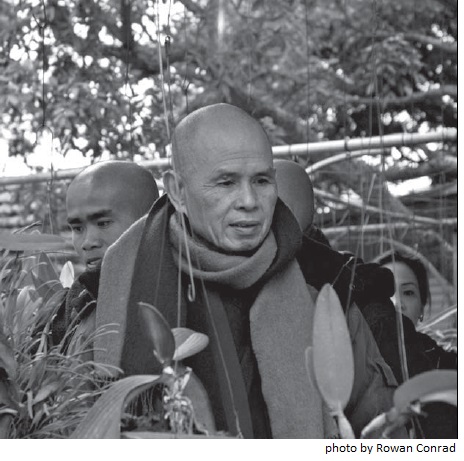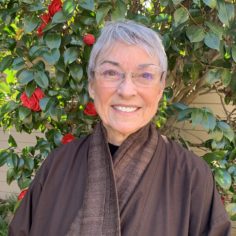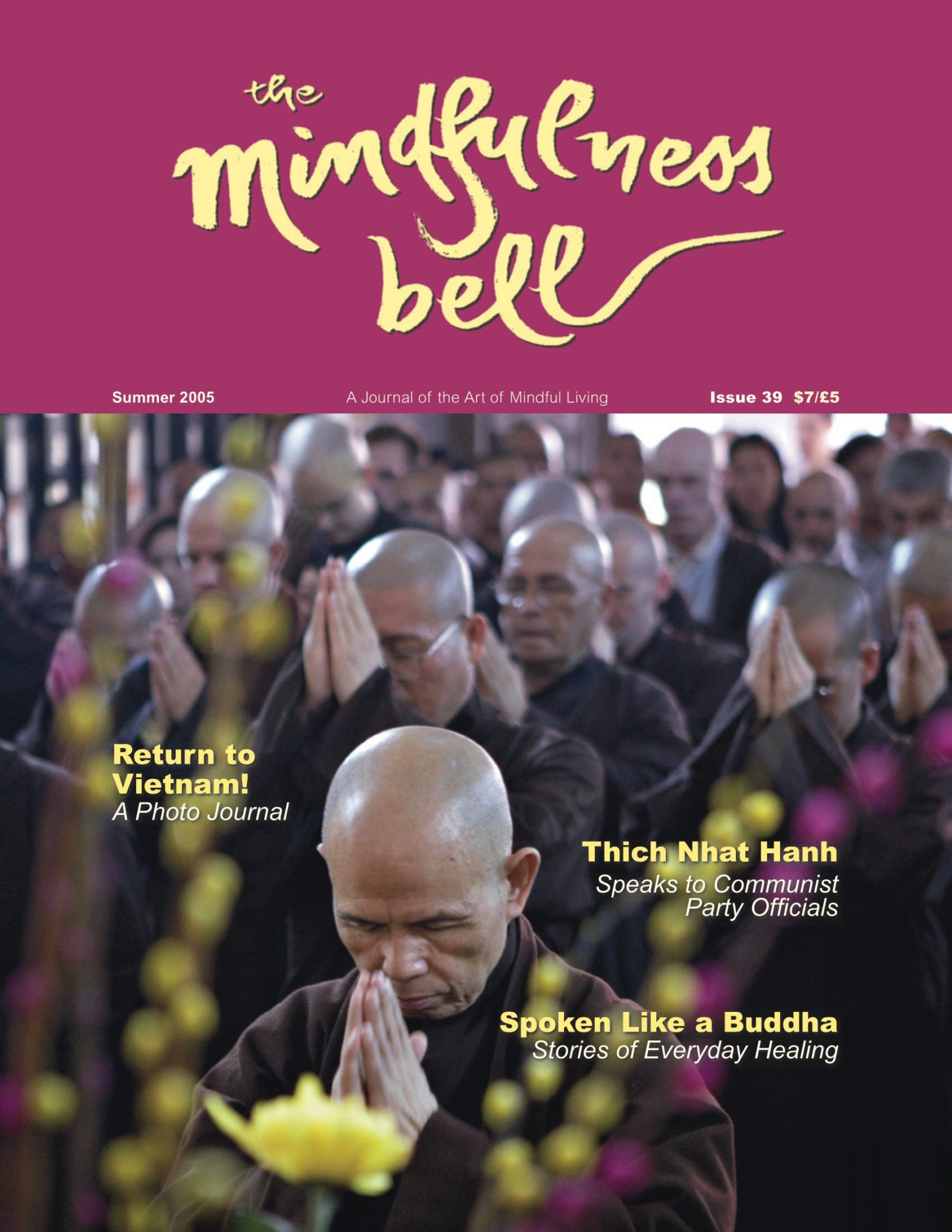By Thich Nhat Hanh, Trish Thompson, Jane Ellen Combelic in June 2005
When Thich Nhat Hanh left Vietnam in 1966 to teach in the United States, he told his friends that he would be back in three months. Thirty-nine years later, he has finally returned. As Thay said in the letter he wrote to the Sangha before the trip, he left as a single cell and returned as a Sangha body.
By Thich Nhat Hanh, Trish Thompson, Jane Ellen Combelic in June 2005
When Thich Nhat Hanh left Vietnam in 1966 to teach in the United States, he told his friends that he would be back in three months. Thirty-nine years later, he has finally returned. As Thay said in the letter he wrote to the Sangha before the trip, he left as a single cell and returned as a Sangha body. Along with the one hundred monks and nuns from Plum Village, approximately three hundred lay people from dozens of countries had the privilege of accompanying Thay. Many of them generously shared their writings and photos with the Mindfulness Bell—we wish we had room to print everything! Look for more impressions in prose, poetry, and pictures in the fall issue.
In a Dharma talk upon his return to Plum Village, Thay said that anyone who was on the journey, especially for the whole three months, was transformed. Each day was packed full of activities, even though Thay reported that he had to turn down ninety-five percent of the invitations he received. Like a delicious, heavy meal, it takes time to digest. “We need to give ourselves at least six months,” he says.
Time will tell what miraculous transformations take place—within each participant in the journey, in the people of Vietnam, in Buddhism worldwide, in our Sangha. Brother Phap Luu has called the journey “Thay’s Magical Mindfulness Tour.” The miracle of mindfulness continues to unfold.
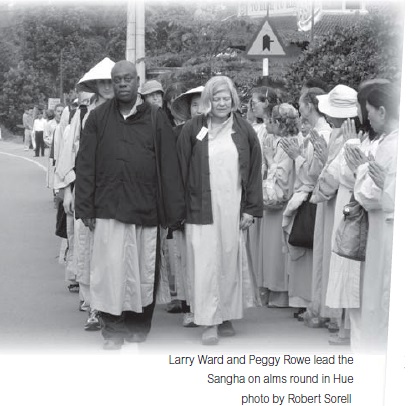
A Letter from Thay to the Sangha Members Going to Vietnam
January, 2005
As the date of our departure to Vietnam approaches, I would like to express my joy and gratitude to all of you for joining me on this historic trip. Our three-month visit will be an offering to the land and people in Vietnam; therefore as a Sangha we would like to offer our best.
When I left Vietnam thirty-nine years ago to come to the West to call for a cessation of the hostilities in my country, I was like a cell of the Sangha body, taken out of that body. If I did not dry up after a few years of being in exile, that is because my practice was to carry the Sangha body in myself. And there was not one day when I did not try to build a Sangha.
While talking and working with friends in Europe and America, I naturally shared the practice, and we always tried to incorporate the practice of mindfulness in our work. I have been able to regenerate a full fourfold Sangha from a single cell. I am therefore going home not as a Sangha cell any more, but as a whole Sangha body. And you are my body.
Vietnam is a beautiful land and a beautiful people, and we shall have the opportunity to contemplate many beautiful things. These will include walking meditation by the Ho Guom lake (Lake of the Returning Sword), climbing Yen Tu Mountain where King Nhan Tong practiced as a monk, and visiting Halong Bay which is considered to be the most fantastic landscape in Asia. Wherever we go, we will practice dwelling happily in the present moment, radiating peace and loving kindness around us. Those of us who stay in hotels will consider our hotel as a practice center, walking, talking, sitting, and eating in mindfulness. All of us will be closely observed, especially by secret agents, who will be able to appreciate our wholesome energy and certainly will profit from it.
The Five Mindfulness Trainings are the most concrete expression of our practice. There will be no consumption of tobacco, meat, or alcohol; no talking while walking; etc. As we practice to be the Sangha body of the Buddha, we are also the body of Thay at the same time. Those of us who are Dharma teachers or Dharma teachers in training will make sure that the practice of the Sangha body is solid, fresh, and joyful. We shall certainly make many people happy with our presence and practice.
When I left Vietnam thirty-nine years ago to come to the West to call for a cessation of the hostilities in my country, I was like a cell of the Sangha body, taken out of that body. If I did not dry up after a few years of being in exile, that is because my practice was to carry the Sangha body in myself. And there was not one day when I did not try to build a Sangha.
While talking and working with friends in Europe and America, I naturally shared the practice, and we always tried to incorporate the practice of mindfulness in our work. I have been able to regenerate a full fourfold Sangha from a single cell. I am therefore going home not as a Sangha cell any more, but as a whole Sangha body. And you are my body.
We’ll be together in a few days
Thay
Hanoi
January 12 to January 22
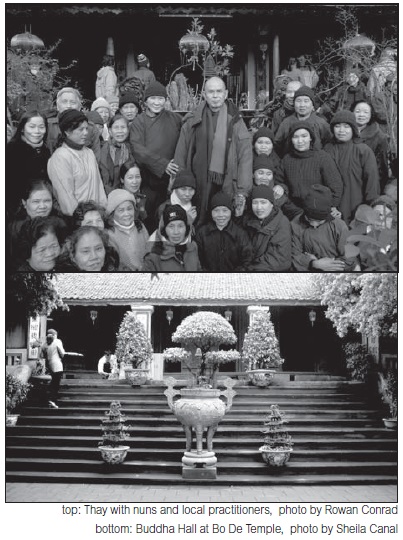
Thay’s Arrival in Hanoi
We all got up at four a.m. to meet Thay and the Plum Village Sangha at Hanoi airport. We arrived to crowds, and more and more people kept coming: monks in bright yellow robes, lots of people with cameras, old men and women wearing amazing regional costumes.
When Thay entered the arrivals hall total mayhem ensued: everyone surged forward, trying to get a glimpse of Thay, who was tightly surrounded by a pair of monks to keep him from being trampled. People threw flowers, climbed on chairs, pushed and pulled, while three film crews tried to get their footage, and countless cameras flashed.
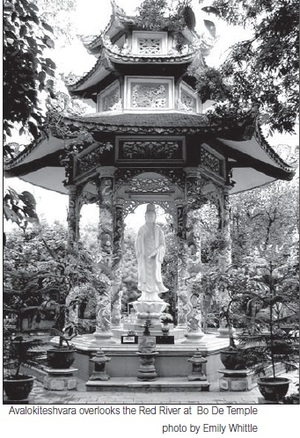
Arriving at Bo De Temple, where Thay and the monastics stayed, rows of people lined the road leading to the temple. As Thay passed they threw flowers, and chanted, and bowed deeply —not just for Thay, but also for us, which was a strange experience. So much devotion!
For me, the most moving moment happened a couple of hours later, when Thay was walking in the temple grounds with Sister Chan Khong and the abbot of Thay’s root temple in Hue. Thay squatted between the cabbages planted around the stupas, picked up some earth and let it flow through his hands, remarking that it was the first time in nearly forty years that he was able to touch the earth of his homeland. The abbot started to cry and I couldn’t stop myself from joining him.
—Evelyn Van de Veen, Shining Strength of the Heart, Amsterdam
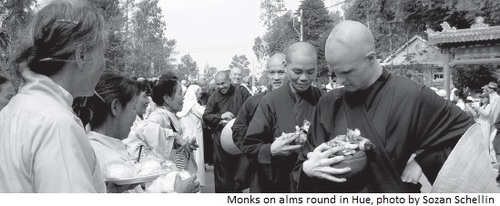
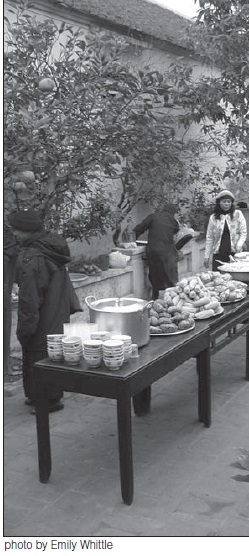
Northern Vietnam
Vietnamese country scenes
Rice paddies and lakes
Big French style homes
And muddy shacks
In rain and cold
Unexpected weather
In farms and cities
People work so hard
Road construction
Buildings go up
In fortune of peace
Vietnam smiles
—Joy Magezis, True Wonderful Commitment, Cambridge, England
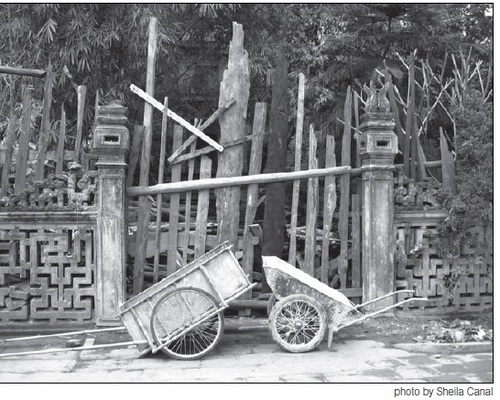
What It Means
Thich Nhat Hanh’s return to Vietnam is about importing the Buddhism he built in the West. When Thay came to the U.S. to try to stop the war, he already had a record of developing practices and approaches that would revitalize Buddhism and meet the real needs of people, both spiritual and material. It was labeled engaged Buddhism, a term that has become synonymous with Thay and his teaching.
Thay started the Order of Interbeing and the School of Youth for Social Service, a kind of Buddhist domestic Peace Corps, where volunteers studied medicine and nursing, economics, agriculture, and architecture and construction. They then went to live in rural villages to help with grassroots development. Thay was not popular with the Buddhist establishment of the time, nor the government. Not taking sides, speaking out against injustice, calling for change got him thirty-nine years in exile, which ended when he landed in Hanoi on January 12.
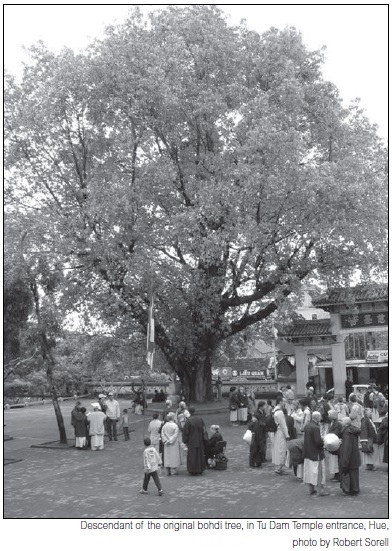
Our job, one hundred monastics and ninety lay persons, was to display Thay’s Buddhism: gender equality; Sangha-centered decision making; lay persons who practice as well as support practice; close and happy relationships among lay and monastic Sangha members; engaged practice; enthusiastically embracing what can be learned from other traditions. These are all new and radical things in Vietnam. A Vietnamese member of the delegation told me, “You are the message. Educated westerners practicing and walking mindfully, that’s the news, that’s what gets the attention, that’s what gives Thay added credibility.”
—Rowan Conrad, True Dharma Strength, Missoula, Montana
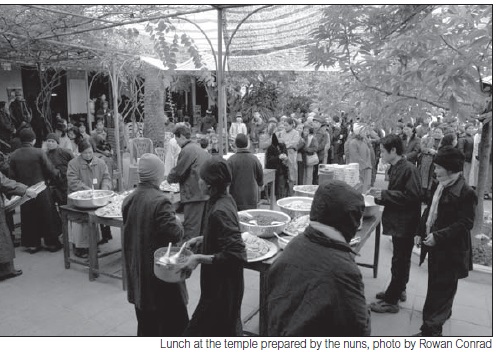
First Days in Hanoi
The trip is starting to find its own rhythm: getting up around 4:30 a.m., having breakfast (sometimes on the bus), and visiting an average of four temples and shrines each day. We are met with exceptional warmth and kindness: people lining the streets, schoolchildren singing, women throwing flowers, followed by a sumptuous meal.
—Evelyn Van de Veen
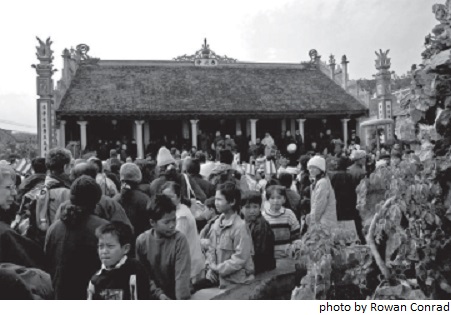
Letting Love
The Vietnamese are giving us a profound teaching with the abundance of love that they offer so effortlessly. Accepting it is easier when we look deeply and see that each one of us represents the love and wisdom that Thay generated over his forty years in exile. To the people who have been without their master, we are a walking, breathing, smiling testament to his life’s work. When I think of myself as capable of being a vessel for peace and wisdom, I feel for the first time that I can receive what comes from other people’s hearts and be deserving of it.
I find myself moving with marked slowness after seeing Thay pass by, because his formless beauty awakens the same in me. At times I find myself moving like him, curling my lips with ease like him, speaking with gentleness like him, and it is in these moments that I have come home. I am not so distinctly me or him; I am a vessel of stillness that is as quiet as a boat on a waveless ocean. Perhaps this is what the Vietnamese see—so many offerings of peace flowing in a river to their temples, warm with burning incense, into their hearts and palms pressed together in prayer.
—Kate Cummings, Asheville, North Carolina
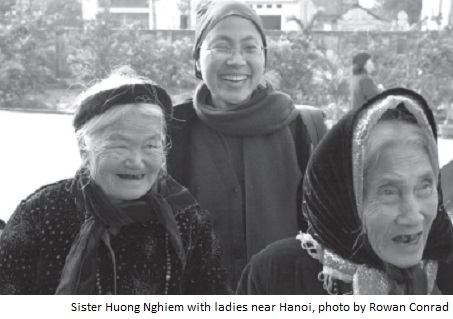
Saigon
January 22 to February 18
A Sea of Monks and Nuns
There was a Day of Mindfulness at Vinh Nghiem Temple, an enormous, modern place with a grand staircase leading up to a huge Buddha statue. The turnout in the south is even bigger than in the north, with a sea of grey robes and bare scalps, packed in knee to knee.
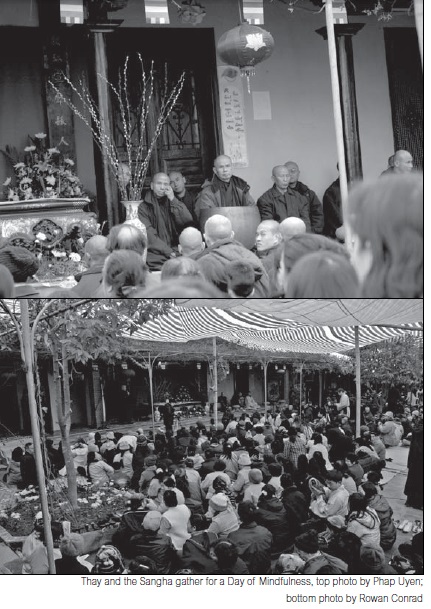
Thay’s tone today was light-hearted and informal. Addressing the Vietnamese monastics, he told about many of the practices at Plum Village, such as shining the light, using Sangha eyes, not going out alone, doing everything together, and working through a democratic system. “Our abbots are not so busy; mostly what they do is drink tea,” he said.
—Alissa Fleet, Boundless Transformation of the Heart, Berkeley, California
Sacred Ground
Thây told us that Dharma Cloud Temple (Chua Phâp Van) is on sacred ground. More than forty years ago Thây designed and built the original thatch-hut temple, and the first classes of the School of Youth for Social Service were held here in 1964. Two years later, the first members of the Order of Interbeing were ordained here. “Phâp Van is the cradle of engaged Buddhism,” says Thây. He describes the beautiful memorial garden where victims of war-time violence are honored: Nhat Chi Mai, one of the original members of the Order of Interbeing, who immolated herself for peace; the two people killed in a grenade attack on the temple; the eight social workers who disappeared, presumed dead; and the four social workers who were shot. “I could no longer cry. I had engaged them and now they were killed.” Thây then reads the letter that Nhat Chi Mai wrote to him before her death; he tells us that Nhat Chi Mai’s sister is in the audience, and even he does not keep the tears from his voice. Then he reads some of his poems.
—Janelle Combelic, Sweet Wisdom of the Heart, Loubès-Bernac, France
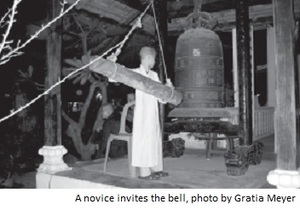
My Teacher Is In Me
In the Dharma talk today, Thay spoke at length about how our parents and grandparents are in us, in every cell of our body, that all our ancestral teachers are in us, as well as our teacher in this lifetime. Afterwards, wandering among the people in the temple courtyard, I was approached by a woman who bowed and offered me a book of Thay’s to sign. (A few of his books are being published, legally, in Vietnamese for the first time). It was open at the title page, and with pen in hand, she insisted that I sign the book! I laughingly resisted, until I remembered—Thay is in me. This woman understood that, and was happy for me to sign the title page, since he could not. So, I happily signed my Vietnamese Dharma name, Chan An Dinh, True Concentration on Peace.
—Trish Thompson, True Concentration on Peace
Heaven on Earth
We took a bus out of Saigon and visited Bat Nha (Prajna Temple). This was among the most beautiful places I’ve ever been. To get there, we drove for two hours through wild, green mountains that rose up dramatically on either side of the winding, two-lane road. Arriving at the temple, we stepped into a utopia deep in tea and coffee plantations. Sloping fields full of tea bushes drop on all sides of this gorgeous refuge, making an almost flat, lush, waist-high green carpet of landscape. The air smelled like jasmine, and red earth paths circled in and around the grounds. From a speaker somewhere, voices were chanting with bells, the effect being nothing short of celestial.
We spent one day and night here, sleeping on the floor in buildings ringing the main temple. I awoke before sunrise to the steady, deep sound of a single drum heartbeat, then heard male voices chanting. I walked outside into the warm air following the sound and entered the temple. Twenty saffron-robed Theravadin monks visiting from Thailand were greeting the day. I sat in back on the smooth marble floor for almost an hour, listening, breathing, absorbing the sense of unity that voice, drum, and quiet early morning created among us. This place, Prajna Temple, deep in Vietnam’s tea fields, is a bit of heaven on earth.
—Lisa Haufschild
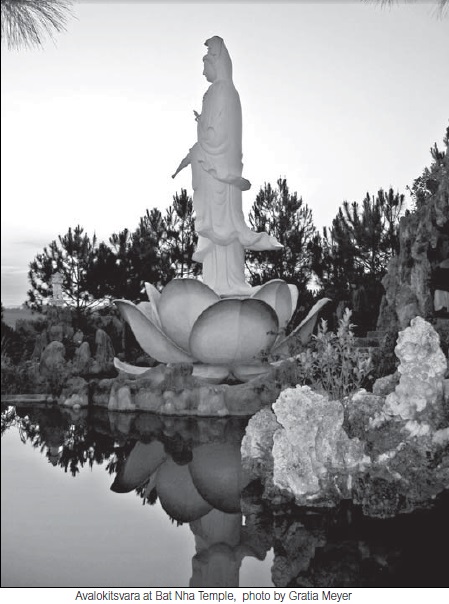
Love Food
I have never had such delicious, simple, lovingly prepared food.
At Phap Van, our main temple in Saigon, food was prepared by the nuns. On temple visits, the women prepare beautiful things. We have had banana leaves folded origami style into octagon shaped boxes holding a coconut tapioca square. Sesame squares are in handmade packets wrapped in colorful gift-wrapped cellophane. Tangerines, the sweetest I’ve ever had, are stacked and wrapped. This is not restaurant food. It is love food.
—Lisa Haufschild
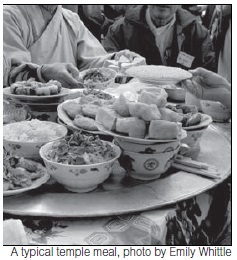
Transformation
By the last evening, people know that Phap Van is no longer an ordinary neighborhood temple where you smoke cigarettes and offer a cursory handful of incense. You can now hear children singing “Breathing In, Breathing Out” and “Here Is the Pure Land.” When something wonderful happens on stage, people know to wave their hands in the air rather than applaud. And when the bell is invited, there is a long moment of settling and quieting. A transformation has clearly happened here: people are listening to the talks with a deeper stillness now.
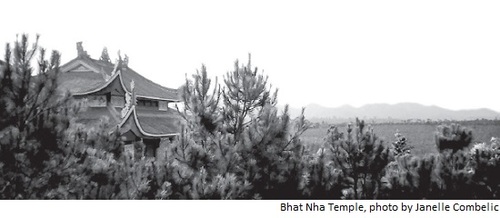
The local practitioners sit beautifully, some with their eyes closed, their hands folded before them. They listen peacefully as Thay delivers his farewell: teachings on interbeing; no coming, no going; no birth, no death. He holds up a sheet of paper, he strikes a match, he watches as the flame goes out. Where did it go? With deep intimacy, Thay speaks directly to each person: some day you might hear that I am deceased. And you might think I am gone. But all you need to do is look deeply to see that I am still here.
—Alissa Fleet
Hue
February 18 to March 15
Thay’s Return to Tu Hieu Pagoda
Walking in long lines in silence we made our way towards the temple entrance. We heard drums in the distance, and traditional Vietnamese music. We were surrounded by trees, the leaves glistening in the damp late morning air. The route was lined with people holding Buddhist flags, flowers, and paper lotuses containing candles. Some cried silently; no one said a word. After fifteen minutes we arrived at an archway, above which a sign said, ‘The Tu Hieu Temple Welcomes the Venerable Thich Nhat Hanh and the International Delegation from Plum Village’.
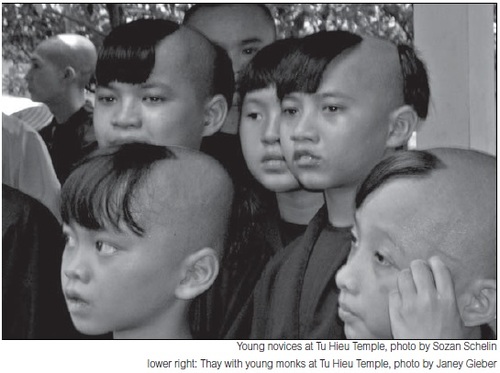
Ahead of me I could see the Half Moon Pond. As Thay stood opposite me, he turned, looked at the pond and said to one of the monastics, “Am I dreaming or is this real?” “It is real, dear Thay,” came the reply.
—Sita Ramamurthy, Compassionate Understanding of the Heart, London
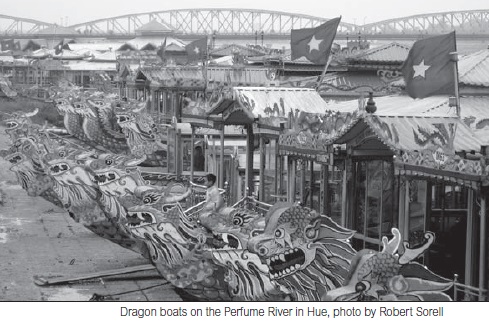
Heaven
Tu Hieu Temple, set in the forest a few miles from town, is where Thay became a monk at the age of sixteen. Our ancestral teacher, Master Nhat Dinh built the hermitage which served as the starting point of this temple in the middle of the nineteenth century. He was a highly respected abbot at a larger temple, but when his mother became ill he decided to find a place to build a small hermitage and take care of her. He found this place, crawling with tigers and thick with forest. Undaunted, he made a little hut for himself and another for his mother. Despite his intentional isolation, disciples found him and eventually it expanded into a monastery.
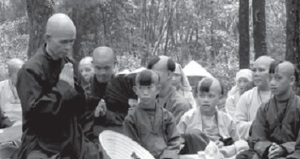
Returning to his childhood home and learning more about his teacher, we are all beginning to understand Thay in a wonderful new way. A remarkable thing is happening — he is looking younger each time I see him. We were told his teacher also began to look markedly younger during the last years of his life. The happiness on Thay’s face makes us all glow.
—Kate Cummings
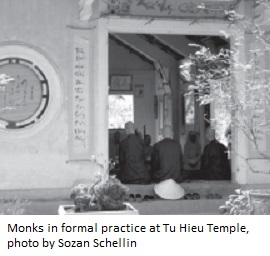
Releasing the Fish
One day the delegation piled into seven boats painted red and yellow with dragon-headed prows. For two hours we floated up the wide and languorous Perfume River, through a landscape of brilliant green forest dotted with the occasional pagoda, village, or cornfield. On the way back, we stopped in the middle of the river across from Thien Mu Pagoda, one of the most famous landmarks in Vietnam. The dragon boat captains maneuvered to face upstream all in a row, anchored, and roped their boats together side by side. From the prow of the central boat, a senior monk led the Ceremony Releasing the Fish. After the monastics chanted the ritual, a monk took a fish out of a tub bubbling with big catfish and ceremoniously released it into the river. Then dozens of squirming fish were given their freedom, more and more, finally whole buckets of them dumped into the water. Such joy!
—Janelle Combelic
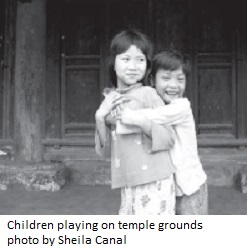
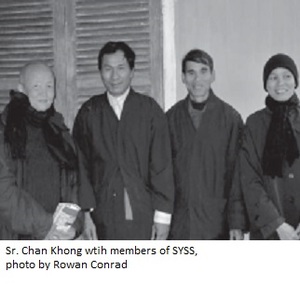
Walking Meditation
Thay and the fourfold Sangha practiced walking meditation through central Hue, Hanoi, and Saigon. In Hue, the traffic was confined to the left side of the busy streets as we walked on the right half. The pavements were lined with people with palms joined. Hundreds more joined the walking meditation along the way until we were a body of many hundreds. This, for me, was a powerful expression of Thay’s teaching that society cannot thrive on economic advancement alone, but needs to have a spiritual dimension.
—Barbara Hickling, True Wonderful Land, Plymouth, Devon, England
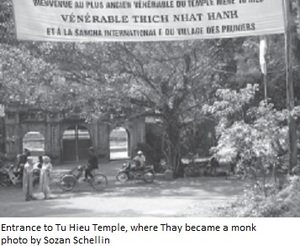
Engaged Buddhism
While the monastics held a one-week retreat at Tu Hieu Temple thirteen lay Dharma teachers led us in a lay retreat. Every day ninety of us came to the Dieu Nghiem nunnery next to Tu Hieu, for sitting and walking meditation, Dharma talks and discussions. The week was a sweet respite from the sometimes befuddling intensity of the pilgrimage. One afternoon we were joined by a dozen Vietnamese members of the Order of Interbeing, including some who had been part of the School of Youth for Social Service, founded by Thay in 1965, as a helping arm of Van Hanh University. Through the war, through the brutal years of communist rule since 1975, often working underground, they have continued feeding the hungry, sheltering the homeless, educating the poor.
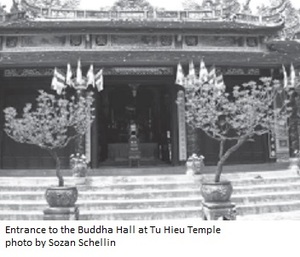
Describing their work over the past forty years and continuing today, they told us: There are many people not cared for by anyone so we build schools and hospitals to care for them. After 1972, lots of people in the South were evacuated so those who remained grew crops to help feed the rest. A lot of blood and sweat was shed on those lands to grow crops. After 1975 all operations were terminated by the government so we stopped officially for several years but continued working underground. In 1985 we received from Plum Village, packages of medicine to sell so we could buy rice to give to people in poor areas.
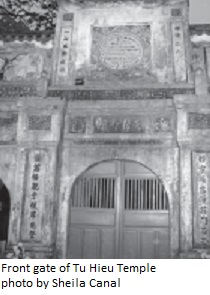
Thay has taught us not to be attached to the political system, so when the government officials ask us to stop, I tell them that we only work in the spirit of loving our people and our country. We can continue because of the nurturing support of the Buddha, of all of you and of the energy of streams of all our ancestors.
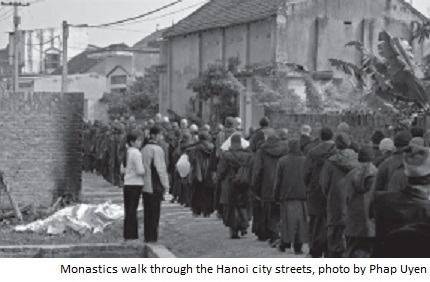
“Thây left us when I was twenty,” said a dignified gentleman with tears in his eyes, “and now we’re all in our sixties. We have missed Thây very much, always hoping and praying that he could return. When he came to Phâp Van temple (in Saigon,where the school was located) and touched our hands we were very emotional, very moved. Having Thay here for the past two months has nurtured us tremendously and we do not wish for him to leave.”
—Contributed by Sozan Schellin, Wild Rivers of the Source, Austin, Texas; Susan Hadler, Transformational Light of the Heart, Washington, D.C.; and Janelle Combelic
Hanoi
March 15 to March 30
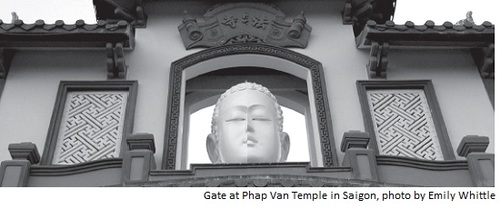
Halong and Yen Tu
Gliding past islands
Stretching up from green water
With tree topped hair
At Halong Bay
What peace
Steaming along
No sign of mines
Long past
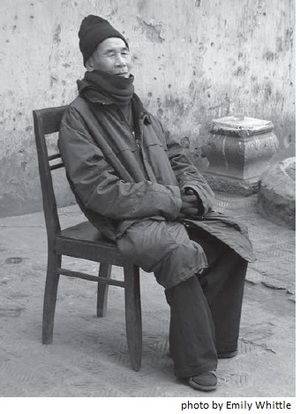
Atop small mountain
Red pagoda
Against grey sky fog hovering at base
Yesterday Yen Tu Mount
Crowds gathered for fest
Climbing muddy rock steps
To Zen King’s home
I climb with Nyu
74 year old pilgrim
Holding hands I support her
Others come past and help
With my grey robe, brown jacket
I’m less an outsider
Nyu translated comments
I smile, laugh with Viets
At heart of island
There wondrous cave
Stalactites drip beauty
Into silent pond
Sangha walk through cave
Stand chanting to Avalokita
Feeling old water energy
Releasing mind to touch joy
—Joy Magezis
Flow
And just how do I step into this beginningless flow? This I am taught by the flow of traffic in Hanoi. I stop and watch, and when I begin to feel myself slow down inside, when trust arises that the flow is there for me to tap into, the fear dissipates and I can see the openings in the traffic. Only after I am aware of this slowness in and outside of myself, have stopped and concentrated on what is flowing right before my eyes, am I ready to step into the traffic. And once I step in, it must be without hesitation; any hesitation separates me from the flow and actually causes danger to others. If I am tired, or shaky, as I often have been in Hanoi, I take the arm of a Sangha sister or brother, and let them lead me into and through. If I am alone, it’s harder. I will wait until someone else is crossing; it could be an old woman or someone carrying large bundles on either end of a bamboo pole, or even a bicycle or motor scooter crossing in my direction. The guide across the river will always come if I am patient, just as the opening in the throngs climbing Yen Tu mountain always came, if I waited and watched.
—Roberta Wall, True Insight of Peace, New York
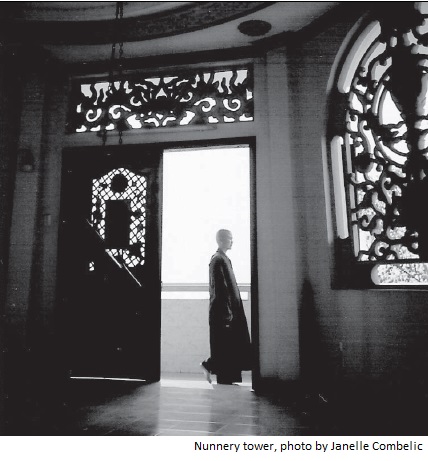
Binh Dinh Province
March 30 to April 10
Monks and Nuns on the Beach
Now we near the sea
Beyond salt drying fields
Sister tells of old home
Then white waves, clear sand
Off the bus we go
Onto peace time beach
Old bunker behind
Young monks jump into sea
Others follow joyfully
Soon half the Sangha’s wet
Brown robes bob in blue sea
Laughter fills the air
—Joy Magezis
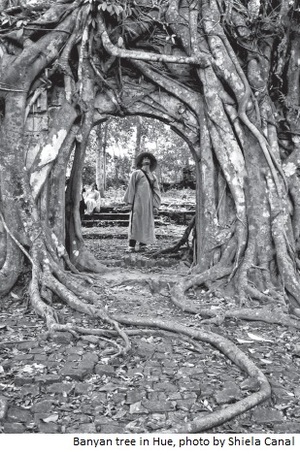
How Was It?
It was exhausting. It was pivotal, I think, for Buddhism in Vietnam. It was a floating celebration. It was a reunion and a triumphal return. It was one of the most profound experiences in my life. Every night I dream about the trip and the Sangha; a different person every night. The night before I wrote this it was about Chuck, the twelve-year-old. The night before that about Terry Barber. Tonight, who knows. Maybe I’ll sleep through the night and won’t remember dreams. But the dreams will be there as Thay lives his dream—returning home and retooling Vietnamese Buddhism for the twenty-first century.
—Rowan Conrad
